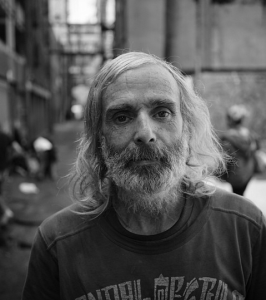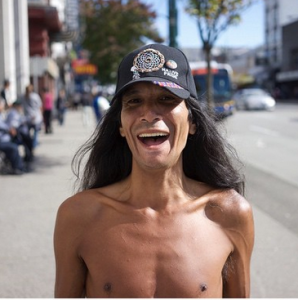The other night as I was winding down for the day, I was exploring Instagram and came across a profile, donovanpee. His feed contains many beautifully raw images of residents from Vancouver’s Downtown Eastside (DTES), and I found myself captivated, scrolling through them well past midnight. Underneath the photos were snippets of conversations with his subjects, some about how long they had been living there, or quotes about something interesting they had to say, or about nothing in particular.
I learned through scrolling his feed that he is a former addict from the DTES, thus allowing him to photograph and interview old friends and familiar faces from the neighbourhood. His experiences also give him insight and compassion about their circumstances, something that many of us don’t have. As I explored this Instagram profile I began thinking about my privileged existence, curled up at that very moment in my warm bed, clean clothing on my back, belly full of food, a roof over my head, fancy smart phone in my hand, and through reading this feed I was able to gain some of Donovan’s compassion and understanding.
Just a few days prior I had begun reading Missing Sarah by Maggie De Vries, learning about Sarah’s story has also given me more perspective. Throughout the book, I found myself wondering why at times she writes about the DTES as if she didn’t understand or was in denial. But like Maggie, sometimes I have found myself hearing things about the DTES that I don’t want to believe or think about at all.
Looking from the outside, or choosing not to look at all, can create a very warped view of what’s known as Canada’s poorest postal code. If you’ve never spent time walking the streets and getting to know the people face to face, it can seem scary and unknown. These mediums are essential to educating people about the DTES and work to remove stigma, break down stereotypes and humanize its residents. After looking around online it became clear to me that this is a movement I was entirely unaware of, and I am excited to see it exists. There are many photographers doing similar work to Donovan’s, and there have been some interesting documentaries too, helping people to realize that the residents of the DTES are not just a spectacle and they don’t deserve to be forgotten about or ignored. Like Sarah and so many others, they have feelings, they are complex, they have a purpose, and have simply fallen onto bad circumstances. It’s important for outsiders of the DTES to understand that a more nuanced view of this neighbourhood can open up their minds and educate them, myself included.



Hi Carly,
Growing up in Vancouver myself, I understand the estrangement of society from this area known as Down Town East Side. My friends have always labeled it as “the sketchy part of Vancouver,” and all my life, I am told never to walk through that area alone. I believe there is a fear produced from the stereotypes placed on this area of town, and the ease of simply looking away and alienating the self from the issues of poverty, homelessness, and prostitution has placed the city into a comfortable, self-induced ignorance. I cannot say I have not placed myself in this ignorance, because I surely have; I fear walking through that part of town without someone with me, and as much as I would like to help those I see, I do not know how.
In grade 12, I decided to do an art portfolio focus on homelessness, and in doing so, I wanted to walk around DTES to take photos and draw out what I saw for a purpose of providing faces and voices for the homeless, and yet I could not get myself to walk about to take pictures. First, I felt insecure about my safety. Second, I was not sure how to approach the people I wished to photograph without seeming rude. I felt so disconnected from the people of DTES, but I question if this disconnection is just self-constructed due to years of exposure to DTES stereotypes.
I am equally glad there are now mediums in which DTES is gaining human faces and personalities. It is accomplishing what I desired to do in grade 12, and I hope the writing and pictures of DTES will help viewers gain a new understanding as I have from reading Missing Sarah.
Thanks for your comment Leona! And thanks for sharing your thoughts/experiences on the DTES. I think, like many Vancouverites, you’re not alone in your feelings about the DTES. I too have really valued my experience of reading Missing Sarah and exploring some of these mediums in order to gain more perspective.
It is interesting how these photos capture something that perhaps an article or narrative would not be able to catch. It reminds me of the site Humans of New York (http://www.humansofnewyork.com) and how just the plain photos themselves re-humanize people, similar to the aim of the Missing Women Commission of Inquiry we studied.
Similarly, the artist Dafy Hagai explores this concept in this photography project “Israeli Girls.” Here is a link to one of the photos (http://www.juxtapoz.com/media/k2/galleries/55577/Screen%20Shot%202014-10-03%20at%209.51.32%20AM.png). The image here captures an element that the narrative cannot. The photo is an equalizer yet creates “the subject” as an individual entity, thus blurring the self vs. other complex.
Callie Hitchcock
Thanks for the links Callie! I have heard of Humans of New York before, what a cool project. There is something so powerful about being able to connect with other people on that level. Rather than an article simply offering a description, these images really allow readers to better relate to and understand the subject.
Hey Carly,
Thank you for your blog post. I have been thinking on the ethics of photography lately (well, for several months) and have come up with many different iterations of life narration through photography of low-income folks or homeless folks that are absolutely abhorrent (no consent, no respect for the subjects photographed, only concerned with capturing the ‘reality’ of poverty). Glad to see something that attempts to capture DTES as the vibrant neighbourhood it is. 🙂
I recommend Susan Sontag’s Regarding the Pain of Others, especially some of the later chapters that talks about photographing colonized subjects and the way photographs construct and affirm national identities for more thoughts in the vein of, specifically, capturing subjects’ pain. Clearly this Instagram is more about capturing everyday-ness, community, joy.
The other day I decided to buy a book called Planet Shanghai (https://www.goodreads.com/book/show/3276655-planet-shanghai) at Oscar’s Art and Books (which has been “closing down” for several months now). I thought about the photographer being white and wondered about the kind of relationship he had with his subjects before buying the book, but I was too excited by the prospects of seeing the people of Shanghai (which isn’t my hometown but where my family currently lives) to be put off.
For other audiences though the book would serve different purposes. Shanghai is after all an economic centre in China, so I imagine that many people would look at it to prepare themselves for potential visits, to better understand Shanghai as a place.
Let me know what you think!
– Jane
Hi Jane, thanks for adding your thoughts to the discussion!
I agree with you on the ethics of photography in these instances, in fact the evening that I was exploring Donovan’s feed, I came across another profile attempting to do similar work, but these photos instead offered a more disturbing angle. The only images shared of the residents of the DTES seemed to be when they were shooting up or tripping out. But something about it didn’t feel right, proper consent wasn’t likely obtained and it seems like exploitation was the only goal.
Thanks for sharing such interesting materials! I took a look at the description and reviews of “Regarding the Pain of Others,” and it looks like a very interesting read, I’ll definitely have to check it out some time.
Oh man, thank you for linking Donovan’s Instagram up here. This is a good thing that he’s doing, putting faces and voices back into the community.
Absolutely!